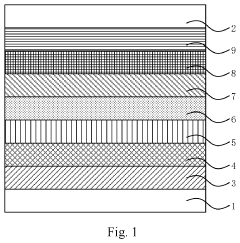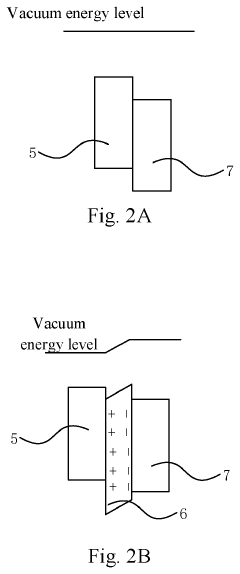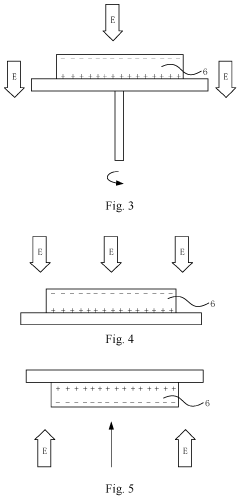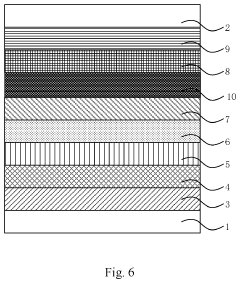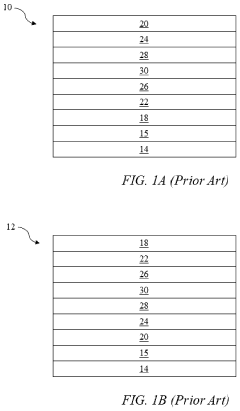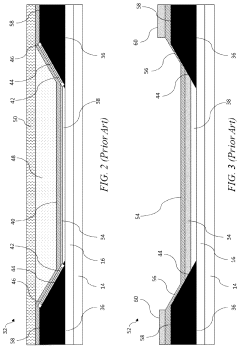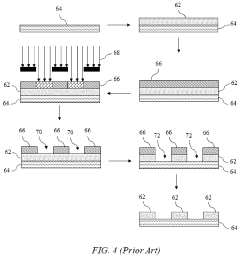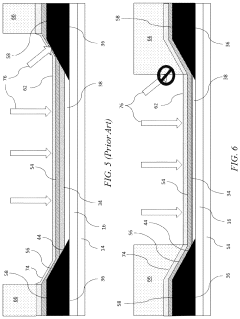QLED Displays: A New Era in Interactive Viewing
JUN 20, 20259 MIN READ
Generate Your Research Report Instantly with AI Agent
Patsnap Eureka helps you evaluate technical feasibility & market potential.
QLED Technology Evolution and Objectives
QLED (Quantum Dot Light-Emitting Diode) technology has emerged as a revolutionary advancement in display technology, marking a significant milestone in the evolution of interactive viewing experiences. The journey of QLED displays began with the discovery of quantum dots in the 1980s, but it wasn't until the early 2000s that researchers started exploring their potential in display applications.
The primary objective of QLED technology is to enhance the visual experience by delivering superior color accuracy, brightness, and energy efficiency compared to traditional LED and OLED displays. This technology aims to overcome the limitations of existing display technologies while providing a more immersive and interactive viewing experience.
As QLED technology progressed, it focused on improving the quantum yield of quantum dots, enhancing their stability, and developing more efficient manufacturing processes. The evolution of QLED displays has been marked by continuous improvements in color gamut, peak brightness, and contrast ratios, pushing the boundaries of what is possible in display technology.
One of the key milestones in QLED development was the introduction of cadmium-free quantum dots, addressing environmental concerns and regulatory requirements. This breakthrough opened up new possibilities for widespread adoption of QLED technology in consumer electronics.
The evolution of QLED displays has also been driven by the increasing demand for larger screens with higher resolutions. As 4K and 8K content becomes more prevalent, QLED technology has adapted to meet these demands while maintaining exceptional picture quality and energy efficiency.
In recent years, the focus of QLED development has shifted towards enhancing interactivity. This includes integrating touch capabilities, improving response times, and developing more sophisticated user interfaces. The goal is to create displays that not only provide stunning visuals but also offer intuitive and responsive interactions.
Looking ahead, the objectives for QLED technology include further improvements in energy efficiency, durability, and flexibility. Researchers are exploring ways to create bendable and foldable QLED displays, opening up new form factors and applications. Additionally, there is a push towards developing self-emissive QLED displays, which could potentially combine the best features of QLED and OLED technologies.
As QLED technology continues to evolve, it aims to redefine the boundaries of interactive viewing. The ultimate goal is to create displays that offer unparalleled visual quality, seamless interactivity, and adaptability to various environments and use cases, ushering in a new era of immersive and engaging visual experiences.
The primary objective of QLED technology is to enhance the visual experience by delivering superior color accuracy, brightness, and energy efficiency compared to traditional LED and OLED displays. This technology aims to overcome the limitations of existing display technologies while providing a more immersive and interactive viewing experience.
As QLED technology progressed, it focused on improving the quantum yield of quantum dots, enhancing their stability, and developing more efficient manufacturing processes. The evolution of QLED displays has been marked by continuous improvements in color gamut, peak brightness, and contrast ratios, pushing the boundaries of what is possible in display technology.
One of the key milestones in QLED development was the introduction of cadmium-free quantum dots, addressing environmental concerns and regulatory requirements. This breakthrough opened up new possibilities for widespread adoption of QLED technology in consumer electronics.
The evolution of QLED displays has also been driven by the increasing demand for larger screens with higher resolutions. As 4K and 8K content becomes more prevalent, QLED technology has adapted to meet these demands while maintaining exceptional picture quality and energy efficiency.
In recent years, the focus of QLED development has shifted towards enhancing interactivity. This includes integrating touch capabilities, improving response times, and developing more sophisticated user interfaces. The goal is to create displays that not only provide stunning visuals but also offer intuitive and responsive interactions.
Looking ahead, the objectives for QLED technology include further improvements in energy efficiency, durability, and flexibility. Researchers are exploring ways to create bendable and foldable QLED displays, opening up new form factors and applications. Additionally, there is a push towards developing self-emissive QLED displays, which could potentially combine the best features of QLED and OLED technologies.
As QLED technology continues to evolve, it aims to redefine the boundaries of interactive viewing. The ultimate goal is to create displays that offer unparalleled visual quality, seamless interactivity, and adaptability to various environments and use cases, ushering in a new era of immersive and engaging visual experiences.
Market Demand for Advanced Display Technologies
The market demand for advanced display technologies has been steadily increasing, driven by the growing consumer appetite for high-quality visual experiences across various devices. QLED (Quantum Dot Light Emitting Diode) displays have emerged as a significant player in this landscape, offering enhanced color accuracy, brightness, and energy efficiency compared to traditional LED and OLED technologies.
In the consumer electronics sector, there is a strong demand for QLED displays in televisions, monitors, and mobile devices. The television market, in particular, has seen a surge in interest for QLED technology, with consumers seeking larger screens with better picture quality for immersive home entertainment experiences. This trend has been further accelerated by the increased time spent at home due to global events, leading to higher investments in home entertainment systems.
The gaming industry has also become a significant driver for QLED display adoption. Gamers are increasingly demanding displays with high refresh rates, low input lag, and vibrant colors, all of which QLED technology can provide. This has led to a growing market for QLED gaming monitors and televisions optimized for gaming experiences.
In the commercial sector, QLED displays are gaining traction in digital signage, control rooms, and large-format displays for public spaces. The technology's ability to deliver bright, clear images even in well-lit environments makes it particularly suitable for these applications. Additionally, the longer lifespan and reduced risk of burn-in compared to OLED make QLED an attractive option for businesses looking for durable display solutions.
The automotive industry is another area where QLED displays are seeing increased demand. As vehicles become more technologically advanced, there is a growing need for high-quality displays for infotainment systems, digital dashboards, and heads-up displays. QLED technology's ability to provide bright, clear visuals even in challenging lighting conditions makes it well-suited for in-vehicle applications.
Market research indicates that the global QLED display market is expected to grow significantly in the coming years. Factors contributing to this growth include technological advancements, decreasing production costs, and increasing consumer awareness of QLED benefits. The market is also being driven by the ongoing transition to 4K and 8K resolution displays, where QLED technology can showcase its superior color reproduction and brightness capabilities.
As the demand for interactive and immersive viewing experiences continues to rise, QLED displays are well-positioned to meet these needs. The technology's ability to support features such as high dynamic range (HDR), wide color gamut, and high refresh rates aligns well with the market's desire for more engaging and lifelike visual content across various applications.
In the consumer electronics sector, there is a strong demand for QLED displays in televisions, monitors, and mobile devices. The television market, in particular, has seen a surge in interest for QLED technology, with consumers seeking larger screens with better picture quality for immersive home entertainment experiences. This trend has been further accelerated by the increased time spent at home due to global events, leading to higher investments in home entertainment systems.
The gaming industry has also become a significant driver for QLED display adoption. Gamers are increasingly demanding displays with high refresh rates, low input lag, and vibrant colors, all of which QLED technology can provide. This has led to a growing market for QLED gaming monitors and televisions optimized for gaming experiences.
In the commercial sector, QLED displays are gaining traction in digital signage, control rooms, and large-format displays for public spaces. The technology's ability to deliver bright, clear images even in well-lit environments makes it particularly suitable for these applications. Additionally, the longer lifespan and reduced risk of burn-in compared to OLED make QLED an attractive option for businesses looking for durable display solutions.
The automotive industry is another area where QLED displays are seeing increased demand. As vehicles become more technologically advanced, there is a growing need for high-quality displays for infotainment systems, digital dashboards, and heads-up displays. QLED technology's ability to provide bright, clear visuals even in challenging lighting conditions makes it well-suited for in-vehicle applications.
Market research indicates that the global QLED display market is expected to grow significantly in the coming years. Factors contributing to this growth include technological advancements, decreasing production costs, and increasing consumer awareness of QLED benefits. The market is also being driven by the ongoing transition to 4K and 8K resolution displays, where QLED technology can showcase its superior color reproduction and brightness capabilities.
As the demand for interactive and immersive viewing experiences continues to rise, QLED displays are well-positioned to meet these needs. The technology's ability to support features such as high dynamic range (HDR), wide color gamut, and high refresh rates aligns well with the market's desire for more engaging and lifelike visual content across various applications.
QLED Display Challenges and Limitations
Despite the promising advancements in QLED display technology, several challenges and limitations persist that hinder its widespread adoption and optimal performance. One of the primary concerns is the issue of color accuracy and consistency. While QLEDs offer vibrant colors and high brightness, maintaining color accuracy across different viewing angles remains a challenge. This can result in color shifts and reduced image quality when viewed from off-center positions, potentially impacting the interactive viewing experience.
Another significant limitation is the potential for burn-in or image retention. Although less prevalent than in OLED displays, QLED screens can still suffer from temporary image retention, especially when static images are displayed for extended periods. This issue can be particularly problematic in interactive applications where certain interface elements may remain on-screen for long durations.
Power consumption is another area of concern for QLED displays. While they are generally more energy-efficient than traditional LED-LCD displays, they still consume more power than OLED alternatives, especially when displaying bright content. This higher power consumption can lead to increased heat generation, potentially affecting the longevity and performance of the display over time.
The manufacturing process for QLED displays also presents challenges. The production of quantum dots requires precise control over particle size and uniformity, which can be difficult to achieve at scale. This complexity in manufacturing can lead to higher production costs and potential yield issues, impacting the overall affordability of QLED technology.
Furthermore, the environmental impact of quantum dot production and disposal remains a concern. Some quantum dot materials contain heavy metals, raising questions about their long-term environmental sustainability and potential health risks associated with improper disposal.
In terms of interactive capabilities, while QLED displays offer excellent brightness and color performance, they may face limitations in touch responsiveness and precision compared to some other display technologies. This can potentially impact the seamlessness of interactive experiences, particularly in applications requiring high-precision touch input.
Lastly, the challenge of achieving true black levels comparable to OLED displays persists. Although QLED technology has made significant strides in improving contrast ratios, it still relies on backlighting, which can result in some light leakage and slightly elevated black levels, potentially impacting the overall visual quality in dark scenes or low-light environments.
Addressing these challenges and limitations will be crucial for the continued advancement and widespread adoption of QLED display technology in interactive viewing applications. Ongoing research and development efforts are focused on overcoming these hurdles to fully realize the potential of QLED displays in creating immersive and responsive interactive experiences.
Another significant limitation is the potential for burn-in or image retention. Although less prevalent than in OLED displays, QLED screens can still suffer from temporary image retention, especially when static images are displayed for extended periods. This issue can be particularly problematic in interactive applications where certain interface elements may remain on-screen for long durations.
Power consumption is another area of concern for QLED displays. While they are generally more energy-efficient than traditional LED-LCD displays, they still consume more power than OLED alternatives, especially when displaying bright content. This higher power consumption can lead to increased heat generation, potentially affecting the longevity and performance of the display over time.
The manufacturing process for QLED displays also presents challenges. The production of quantum dots requires precise control over particle size and uniformity, which can be difficult to achieve at scale. This complexity in manufacturing can lead to higher production costs and potential yield issues, impacting the overall affordability of QLED technology.
Furthermore, the environmental impact of quantum dot production and disposal remains a concern. Some quantum dot materials contain heavy metals, raising questions about their long-term environmental sustainability and potential health risks associated with improper disposal.
In terms of interactive capabilities, while QLED displays offer excellent brightness and color performance, they may face limitations in touch responsiveness and precision compared to some other display technologies. This can potentially impact the seamlessness of interactive experiences, particularly in applications requiring high-precision touch input.
Lastly, the challenge of achieving true black levels comparable to OLED displays persists. Although QLED technology has made significant strides in improving contrast ratios, it still relies on backlighting, which can result in some light leakage and slightly elevated black levels, potentially impacting the overall visual quality in dark scenes or low-light environments.
Addressing these challenges and limitations will be crucial for the continued advancement and widespread adoption of QLED display technology in interactive viewing applications. Ongoing research and development efforts are focused on overcoming these hurdles to fully realize the potential of QLED displays in creating immersive and responsive interactive experiences.
Current QLED Display Solutions
01 Interactive QLED display technology
QLED displays are being enhanced with interactive features, allowing users to engage with content through touch, gesture, or other input methods. This technology combines the high visual quality of QLED with interactive capabilities, creating immersive viewing experiences for applications in entertainment, education, and professional settings.- QLED display technology for interactive viewing: QLED (Quantum Dot Light Emitting Diode) technology is utilized in displays to enhance interactive viewing experiences. These displays offer improved color accuracy, brightness, and contrast, making them ideal for interactive applications. The quantum dot layer in QLED displays allows for more precise light control and color reproduction, resulting in more vivid and lifelike images for interactive content.
- Touch-enabled QLED displays for interactivity: QLED displays are integrated with touch-sensitive technology to enable direct user interaction. These touch-enabled QLED displays allow users to interact with content through gestures, taps, and swipes. The combination of QLED's superior image quality and touch capabilities creates an immersive and responsive interactive viewing experience.
- Interactive content optimization for QLED displays: Software and algorithms are developed to optimize interactive content specifically for QLED displays. These optimizations take advantage of QLED's unique color gamut and brightness capabilities to enhance the visual quality of interactive elements. Content adaptation techniques ensure that interactive features are displayed with maximum clarity and impact on QLED screens.
- Multi-view and 3D interactive experiences on QLED displays: QLED technology is applied to create multi-view and 3D interactive experiences. These displays can support multiple viewing angles and 3D content without the need for special glasses. The high refresh rates and color accuracy of QLED displays contribute to smooth and realistic 3D interactive viewing, enhancing user engagement and immersion.
- Integration of sensors and AI for enhanced interactivity: QLED displays are equipped with various sensors and artificial intelligence capabilities to enhance interactive viewing. These may include gesture recognition, eye-tracking, and voice control features. The integration of AI allows the display to adapt to user preferences and environmental conditions, creating a more personalized and responsive interactive viewing experience.
02 Improved color and brightness in interactive QLED displays
Advancements in QLED technology focus on enhancing color reproduction and brightness for interactive displays. These improvements result in more vibrant and accurate visuals, even in high-ambient light conditions, making them ideal for interactive applications that require precise color representation and high visibility.Expand Specific Solutions03 Integration of sensors for enhanced interactivity
QLED displays are being integrated with various sensors to improve interactivity. These sensors can detect touch, proximity, or gestures, allowing for more intuitive and responsive user interactions. This integration enables new ways of engaging with content and controlling display functions without traditional input devices.Expand Specific Solutions04 Multi-view and 3D capabilities in interactive QLED displays
Interactive QLED displays are incorporating multi-view and 3D technologies to create more immersive viewing experiences. These features allow multiple users to see different content on the same screen or provide depth perception for 3D content, enhancing interactivity and engagement in gaming, virtual reality, and collaborative work environments.Expand Specific Solutions05 Software and user interface innovations for interactive viewing
Advancements in software and user interface design are enhancing the interactive viewing experience on QLED displays. These innovations include intuitive gesture controls, personalized content recommendations, and seamless integration with smart home systems, making it easier for users to navigate and interact with content on large-format QLED displays.Expand Specific Solutions
Key QLED Display Manufacturers and Competitors
The QLED display market is in a growth phase, with increasing adoption across various sectors. The market size is expanding rapidly, driven by demand for high-quality, energy-efficient displays. Technologically, QLED displays are maturing, with key players like Samsung Display, LG Display, and BOE Technology Group leading innovation. These companies, along with others like TCL China Star Optoelectronics and Sharp, are investing heavily in R&D to enhance color accuracy, brightness, and longevity. The competitive landscape is intense, with established electronics giants competing against specialized display manufacturers. As the technology evolves, we're seeing a trend towards larger screens, improved HDR capabilities, and integration with smart features, indicating a promising future for QLED in the interactive viewing space.
BOE Technology Group Co., Ltd.
Technical Solution: BOE has developed advanced QLED display technology that utilizes quantum dots to enhance color gamut and brightness. Their QLED panels incorporate a quantum dot layer between the LED backlight and LCD panel, resulting in improved color accuracy and wider color gamut. BOE's QLED displays also feature local dimming technology for better contrast ratios and HDR performance. The company has invested heavily in research and development to optimize quantum dot materials and manufacturing processes, aiming to reduce production costs while maintaining high-quality output.
Strengths: Wide color gamut, high brightness, and improved energy efficiency. Weaknesses: Higher production costs compared to traditional LCD, potential for burn-in with static images.
Sharp Corp.
Technical Solution: Sharp has developed its own QLED technology under the AQUOS brand, focusing on combining quantum dots with their proprietary UV+B LED backlighting system. This approach aims to achieve a wider color gamut and higher color purity compared to traditional LED-LCD displays. Sharp's QLED displays also incorporate advanced local dimming technology and AI-enhanced picture processing to improve contrast and overall image quality. The company has invested in research to optimize quantum dot materials for better efficiency and longevity, addressing concerns about blue light emissions and potential health impacts.
Strengths: High color purity, energy-efficient UV+B LED backlighting. Weaknesses: Limited market presence compared to larger competitors, potentially higher costs due to proprietary technology.
Core QLED Innovations and Patents
QLED display panel and preparation method thereof and display apparatus
PatentActiveUS20210249620A1
Innovation
- Incorporating ionic coordination compound layers with built-in electric fields between the hole transport layer and quantum dot luminescent layer, and between the electron transport layer and quantum dot luminescent layer, to alter vacuum energy levels and reduce potential barriers, thereby improving hole injection efficiency and balancing carriers.
Combined auxiliary electrode and partially scattering bank for three-dimensional QLED pixel
PatentActiveUS11864402B2
Innovation
- A top emitting QLED apparatus with a reflective auxiliary electrode and a transparent conductive electrode comprising nanoparticles, along with a partially light scattering surface, is designed to enhance light extraction by reflecting internally reflected light and broadening the reflective angle range, while a thinner transparent conductive electrode on sloped portions is made more resilient to wet etching processes.
Environmental Impact of QLED Technology
The environmental impact of QLED technology is a crucial consideration as this display technology gains prominence in the interactive viewing landscape. QLED displays offer several environmental advantages over traditional display technologies, particularly in terms of energy efficiency and longevity.
QLED screens consume significantly less power compared to conventional LCD and OLED displays, resulting in reduced energy consumption throughout their lifecycle. This energy efficiency translates to lower carbon emissions associated with powering these devices, contributing to a smaller environmental footprint. Additionally, the longer lifespan of QLED displays means fewer replacements are needed over time, potentially reducing electronic waste.
The manufacturing process of QLED displays also presents some environmental benefits. Unlike OLED technology, which relies on organic materials that can be challenging to produce and dispose of, QLED uses inorganic quantum dots. These quantum dots are more stable and less prone to degradation, potentially reducing the environmental impact of both production and disposal.
However, the environmental impact of QLED technology is not without concerns. The production of quantum dots often involves the use of heavy metals, such as cadmium, which can pose environmental risks if not properly managed. While efforts are being made to develop cadmium-free quantum dots, the industry is still in transition.
Recycling QLED displays presents both challenges and opportunities. The presence of quantum dots and other specialized materials requires advanced recycling processes to effectively recover and reuse components. As the technology becomes more widespread, developing efficient recycling methods will be crucial to mitigate potential environmental impacts.
The durability of QLED displays contributes to their overall environmental profile. With better resistance to image retention and burn-in compared to OLED technology, QLED screens may require less frequent replacement, reducing the overall consumption of resources and generation of electronic waste.
As QLED technology continues to evolve, ongoing research is focused on further improving its environmental performance. This includes developing more eco-friendly quantum dot materials, enhancing energy efficiency, and designing displays with easier end-of-life recycling in mind. The industry's commitment to addressing environmental concerns will play a significant role in shaping the future sustainability of QLED technology in the interactive viewing market.
QLED screens consume significantly less power compared to conventional LCD and OLED displays, resulting in reduced energy consumption throughout their lifecycle. This energy efficiency translates to lower carbon emissions associated with powering these devices, contributing to a smaller environmental footprint. Additionally, the longer lifespan of QLED displays means fewer replacements are needed over time, potentially reducing electronic waste.
The manufacturing process of QLED displays also presents some environmental benefits. Unlike OLED technology, which relies on organic materials that can be challenging to produce and dispose of, QLED uses inorganic quantum dots. These quantum dots are more stable and less prone to degradation, potentially reducing the environmental impact of both production and disposal.
However, the environmental impact of QLED technology is not without concerns. The production of quantum dots often involves the use of heavy metals, such as cadmium, which can pose environmental risks if not properly managed. While efforts are being made to develop cadmium-free quantum dots, the industry is still in transition.
Recycling QLED displays presents both challenges and opportunities. The presence of quantum dots and other specialized materials requires advanced recycling processes to effectively recover and reuse components. As the technology becomes more widespread, developing efficient recycling methods will be crucial to mitigate potential environmental impacts.
The durability of QLED displays contributes to their overall environmental profile. With better resistance to image retention and burn-in compared to OLED technology, QLED screens may require less frequent replacement, reducing the overall consumption of resources and generation of electronic waste.
As QLED technology continues to evolve, ongoing research is focused on further improving its environmental performance. This includes developing more eco-friendly quantum dot materials, enhancing energy efficiency, and designing displays with easier end-of-life recycling in mind. The industry's commitment to addressing environmental concerns will play a significant role in shaping the future sustainability of QLED technology in the interactive viewing market.
QLED Integration with Smart Home Ecosystems
The integration of QLED displays with smart home ecosystems represents a significant advancement in creating seamless, interactive living environments. As QLED technology continues to evolve, its potential to become a central hub for smart home control and information display is becoming increasingly apparent.
QLED displays, with their superior color accuracy, brightness, and energy efficiency, are well-positioned to serve as the primary interface for smart home systems. These displays can act as large, vibrant control panels, allowing users to manage various aspects of their smart home, from lighting and temperature control to security systems and entertainment devices.
One of the key advantages of integrating QLED displays with smart home ecosystems is the ability to provide real-time, visually rich information. For instance, a QLED display in the living room could show energy consumption data, security camera feeds, or weather forecasts, all while maintaining its primary function as an entertainment device. This multi-functionality enhances the overall user experience and maximizes the utility of the display.
Voice control integration is another crucial aspect of this integration. By combining QLED displays with voice assistants like Amazon Alexa or Google Assistant, users can control their entire smart home ecosystem through voice commands while receiving visual feedback on the QLED screen. This creates a more intuitive and accessible interface for users of all ages and abilities.
The integration also opens up new possibilities for personalized experiences. QLED displays can recognize individual users and automatically adjust settings based on their preferences, from favorite TV shows to preferred lighting scenes. This level of customization enhances user satisfaction and engagement with the smart home system.
Furthermore, the high resolution and color accuracy of QLED displays make them ideal for displaying art when not in use for other purposes. This feature, often referred to as "Art Mode," allows the display to blend seamlessly into the home decor, displaying high-quality digital art or personal photos.
As smart home technologies continue to advance, we can expect to see even deeper integration with QLED displays. Future developments may include augmented reality overlays for home management, more sophisticated AI-driven personalization, and enhanced interoperability with a wider range of smart devices and services.
In conclusion, the integration of QLED displays with smart home ecosystems represents a significant step towards creating more intelligent, responsive, and user-friendly living spaces. As this technology continues to evolve, it has the potential to revolutionize how we interact with our homes and the devices within them.
QLED displays, with their superior color accuracy, brightness, and energy efficiency, are well-positioned to serve as the primary interface for smart home systems. These displays can act as large, vibrant control panels, allowing users to manage various aspects of their smart home, from lighting and temperature control to security systems and entertainment devices.
One of the key advantages of integrating QLED displays with smart home ecosystems is the ability to provide real-time, visually rich information. For instance, a QLED display in the living room could show energy consumption data, security camera feeds, or weather forecasts, all while maintaining its primary function as an entertainment device. This multi-functionality enhances the overall user experience and maximizes the utility of the display.
Voice control integration is another crucial aspect of this integration. By combining QLED displays with voice assistants like Amazon Alexa or Google Assistant, users can control their entire smart home ecosystem through voice commands while receiving visual feedback on the QLED screen. This creates a more intuitive and accessible interface for users of all ages and abilities.
The integration also opens up new possibilities for personalized experiences. QLED displays can recognize individual users and automatically adjust settings based on their preferences, from favorite TV shows to preferred lighting scenes. This level of customization enhances user satisfaction and engagement with the smart home system.
Furthermore, the high resolution and color accuracy of QLED displays make them ideal for displaying art when not in use for other purposes. This feature, often referred to as "Art Mode," allows the display to blend seamlessly into the home decor, displaying high-quality digital art or personal photos.
As smart home technologies continue to advance, we can expect to see even deeper integration with QLED displays. Future developments may include augmented reality overlays for home management, more sophisticated AI-driven personalization, and enhanced interoperability with a wider range of smart devices and services.
In conclusion, the integration of QLED displays with smart home ecosystems represents a significant step towards creating more intelligent, responsive, and user-friendly living spaces. As this technology continues to evolve, it has the potential to revolutionize how we interact with our homes and the devices within them.
Unlock deeper insights with Patsnap Eureka Quick Research — get a full tech report to explore trends and direct your research. Try now!
Generate Your Research Report Instantly with AI Agent
Supercharge your innovation with Patsnap Eureka AI Agent Platform!
